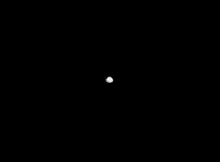Flyby (spaceflight)
When talking about spaceflight, a flyby is when a spacecraft passes close to another object, and takes some measurements, or pictures. Sometimes, the spacecraft uses the other object to gain speed or to change direction, in an operation called gravity assist.[1]


Spacecraft that are specially designed for this task are known as flyby spacecraft. Important parameters of a flyby are the time and the distance of the closest approach.[2]
Flyby maneuvers can be done with a planet, a natural satellite or a non-planetary object such as a small Solar System body.[3][4]
Planetary flybys have occurred with Mars or Earth amongst others.
Kuiper belt change
The New Horizons spacecraft did a fly by the Kuiper belt object 486958 Arrokoth on New Year's Day 2019, after its successful flyby of the dwarf planet Pluto in 2015.[5]
On the night of December 31, 2018 to the morning of January 1, 2019 New Horizons performed the most distant flyby to date, of the Kuiper belt object Arrokoth. New Horizons previously did a flyby of Pluto in July 2015, and that was at about 32.9 AU (astronomical units) from the Sun, while the New Year's Day 2019 flyby of the Kuiper object Arrokoth was at 43.6 AU.[6][7]
Cassini change
Cassini · Saturn · Enceladus · Titan · Iapetus
Cassini-Huygens (launched 1997) orbited Saturn from 2004-2017. It performed flybys of many of Saturn's moons including Titan.[2] Cassini-Huygen's had its first flyby of Titan in October 2004.[2]
Cassini conducted many flybys at various distances of the moons of Saturn.[8] It achieved 126 flybys of Titan, and its final close flyby was on April 22, 2017 before its retirement.[9]
An animation of the Cassini spacecraft trajectory around Saturn over 10 years, during which it passed closely by many moons of Saturn, is at right.
Comets change
International Cometary Explorer (ISEE-3) passed through the plasma tail of comet Giacobini-Zinner doing a flyby of the distance of 7,800 km (4,800 mi) of the nucleus on September 11, 1985.
In 2010, the Deep Impact spacecraft, on the EPOXI mission did a flyby of comet Hartley 2.[10]
Natural flyby change
Flyby is also used to describe when, for example, an asteroid approaches and flies by the Earth.[11][12]
This was also the term for when a comet did a flyby of Mars in 2014.[13]
P/2016 BA14 was radar imaged at distance of 2.2 million miles (3,500,000 km) from Earth in 2016, during its flyby.[14] This enabled the size of the nucleus to be calculated to about 3,300 feet (1 km) in diameter.[14]
On December 16, 2018 the short period comet 46P/Wirtanen had its closest approach of Earth, coming within 7.1 million miles or 11.4 million kilometres (one of its closest approaches to Earth).[15]
References change
- ↑ "Basics of Space Flight - Solar System Exploration: NASA Science". Solar System Exploration: NASA Science. Retrieved 2018-11-04.
- ↑ 2.0 2.1 2.2 "Titan A Flyby Closest Approach". sci.esa.int. Retrieved 2018-11-04.
- ↑ "Our SpaceFlight Heritage: ICE—The first comet flyby". SpaceFlight Insider. 2018-09-12. Archived from the original on 2021-12-18. Retrieved 2018-11-04.
- ↑ "First mission to Mars: Mariner 4's special place in history | Cosmos". cosmosmagazine.com. 13 July 2017. Archived from the original on 2018-11-04. Retrieved 2018-11-04.
- ↑ "2014 MU69: Next Target for New Horizons". Space.com. Retrieved 2018-11-04.
- ↑ Bagenal, F.; Delamere, P. A.; Elliott, H. A.; Hill, M. E.; Lisse, C. M.; McComas, D. J.; McNutt Jr, R. L.; Richardson, J. D.; Smith, C. W. (2015). "Solar wind at 33 AU: Setting bounds on the Pluto interaction for New Horizons". Journal of Geophysical Research: Planets. 120 (9): 1497–1511. arXiv:1509.04660. Bibcode:2015JGRE..120.1497B. doi:10.1002/2015JE004880. S2CID 118518239.
- ↑ "New Horizons". pluto.jhuapl.edu. Retrieved 2018-10-26.
- ↑ "Titan Flyby T-126: Final Close Encounter, Gateway to the Grand Finale".
- ↑ "Titan Flyby T-126: Final Close Encounter, Gateway to the Grand Finale". Solar System Exploration: NASA Science. Retrieved 2019-01-03.
- ↑ Grossman, Lisa (2010-11-04). "New Super Close-Up Images From Comet Flyby". Wired. ISSN 1059-1028. Retrieved 2019-01-01.
- ↑ "Two Small Asteroids Are Buzzing Earth This Weekend. See One Live Tonight!". Space.com. Retrieved 2018-11-04.
- ↑ "Asteroid seen after it makes the closest flyby of the year". CNET. 2018-08-13. Retrieved 2018-11-04.
- ↑ "Comet's 2014 Mars Flyby Caused Most Intense Meteor Shower Ever Recorded". Space.com. Retrieved 2018-11-04.
- ↑ 14.0 14.1 "Flyby Comet Was WAY Bigger Than Thought". Space.com. Retrieved 2018-11-07.
- ↑ "Brightest comet of the year will zoom near Earth this week". USA Today.